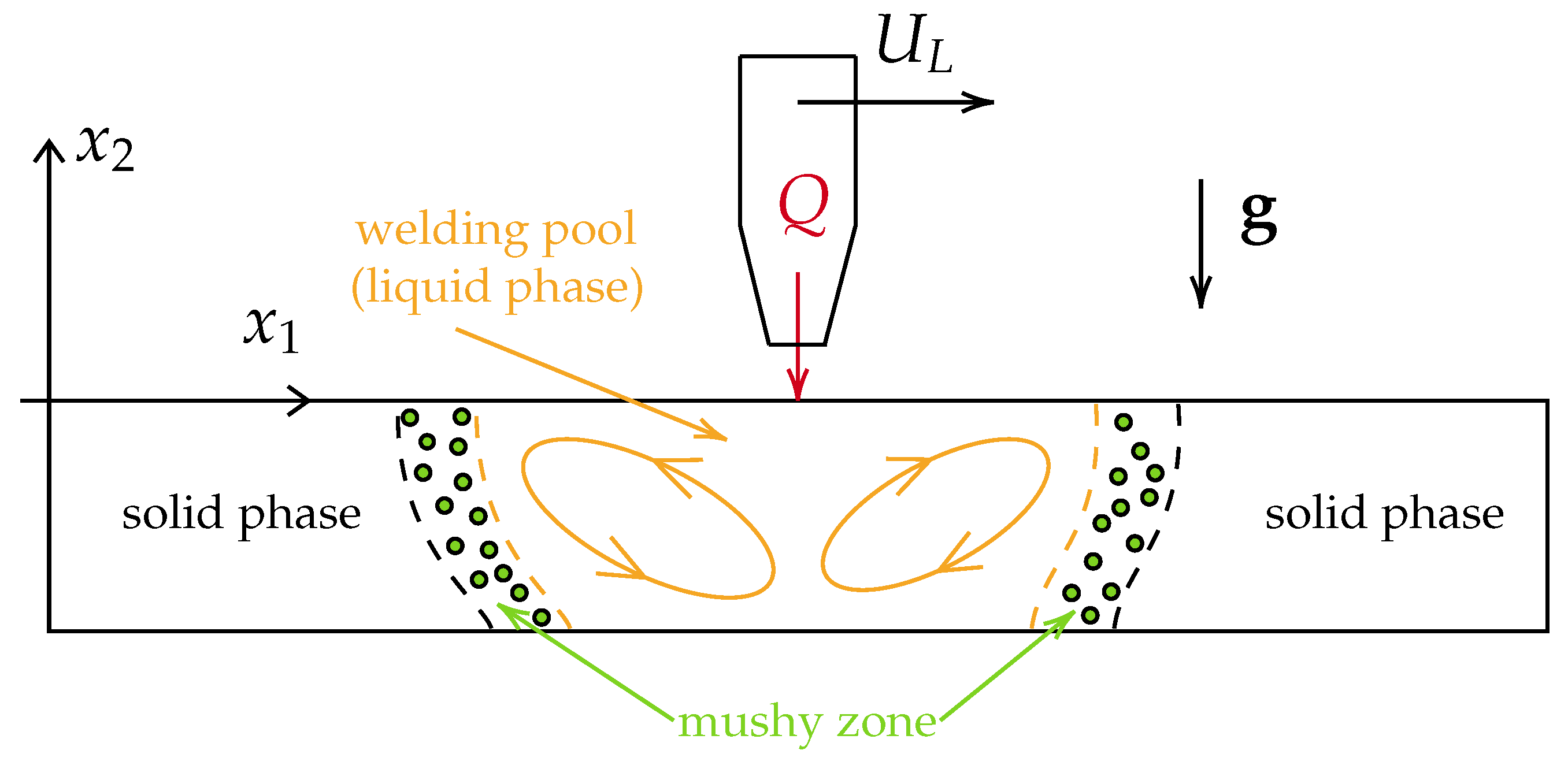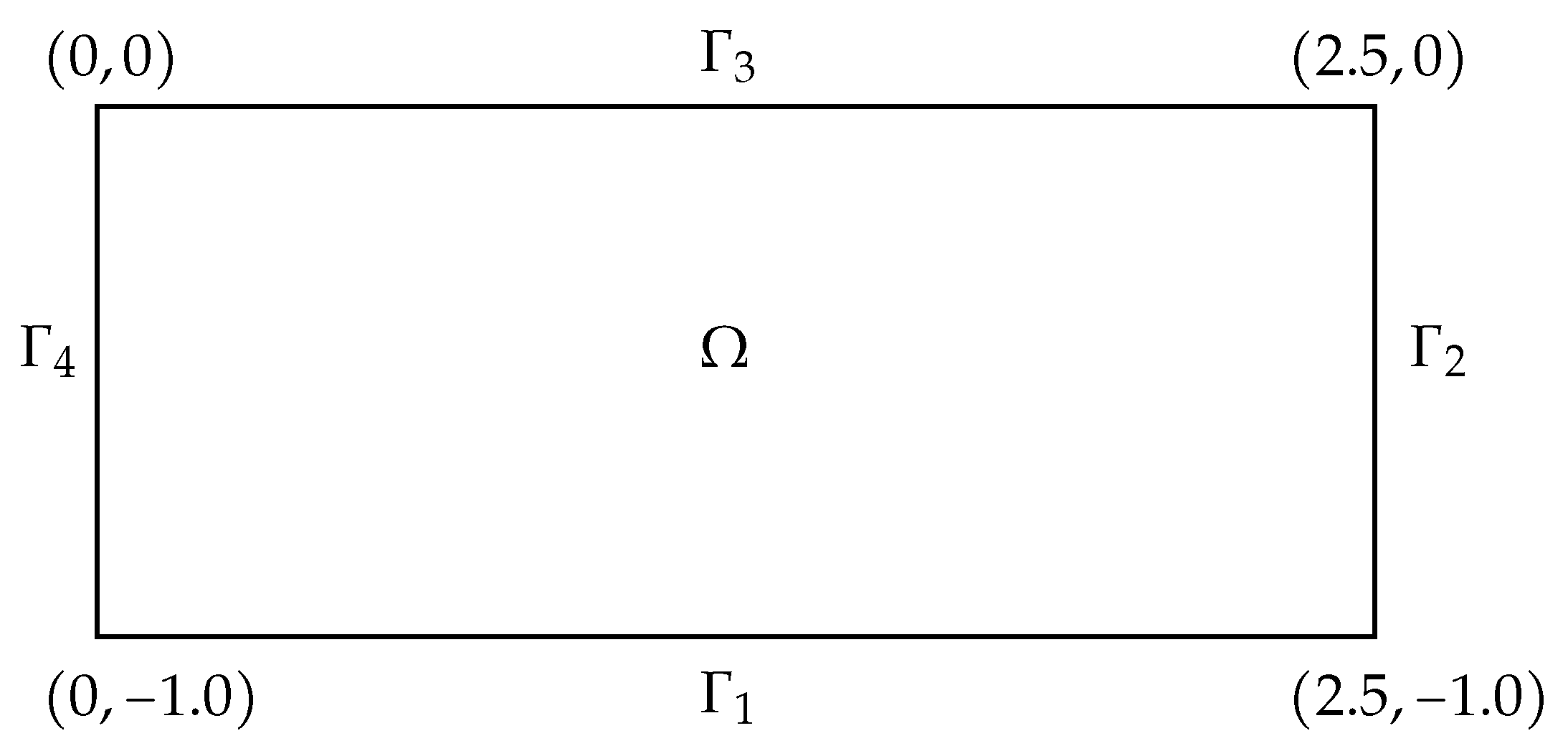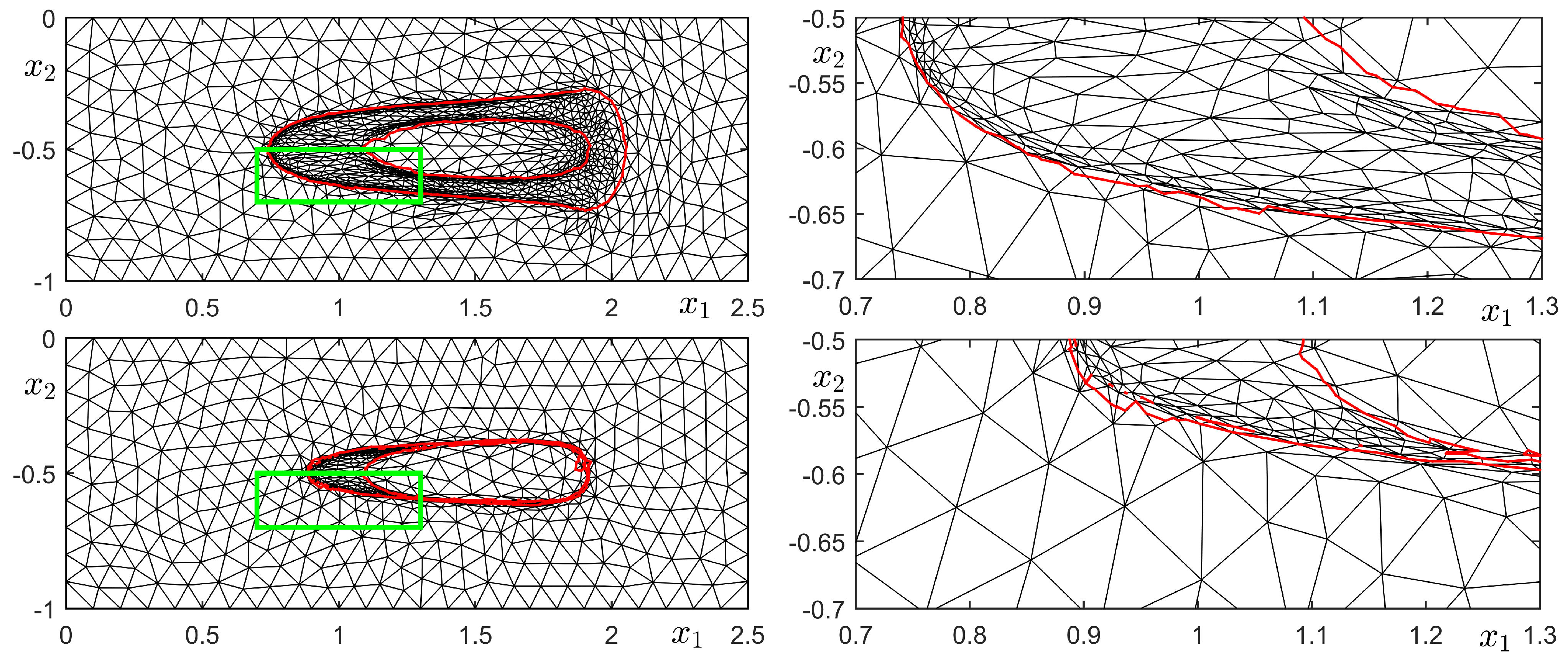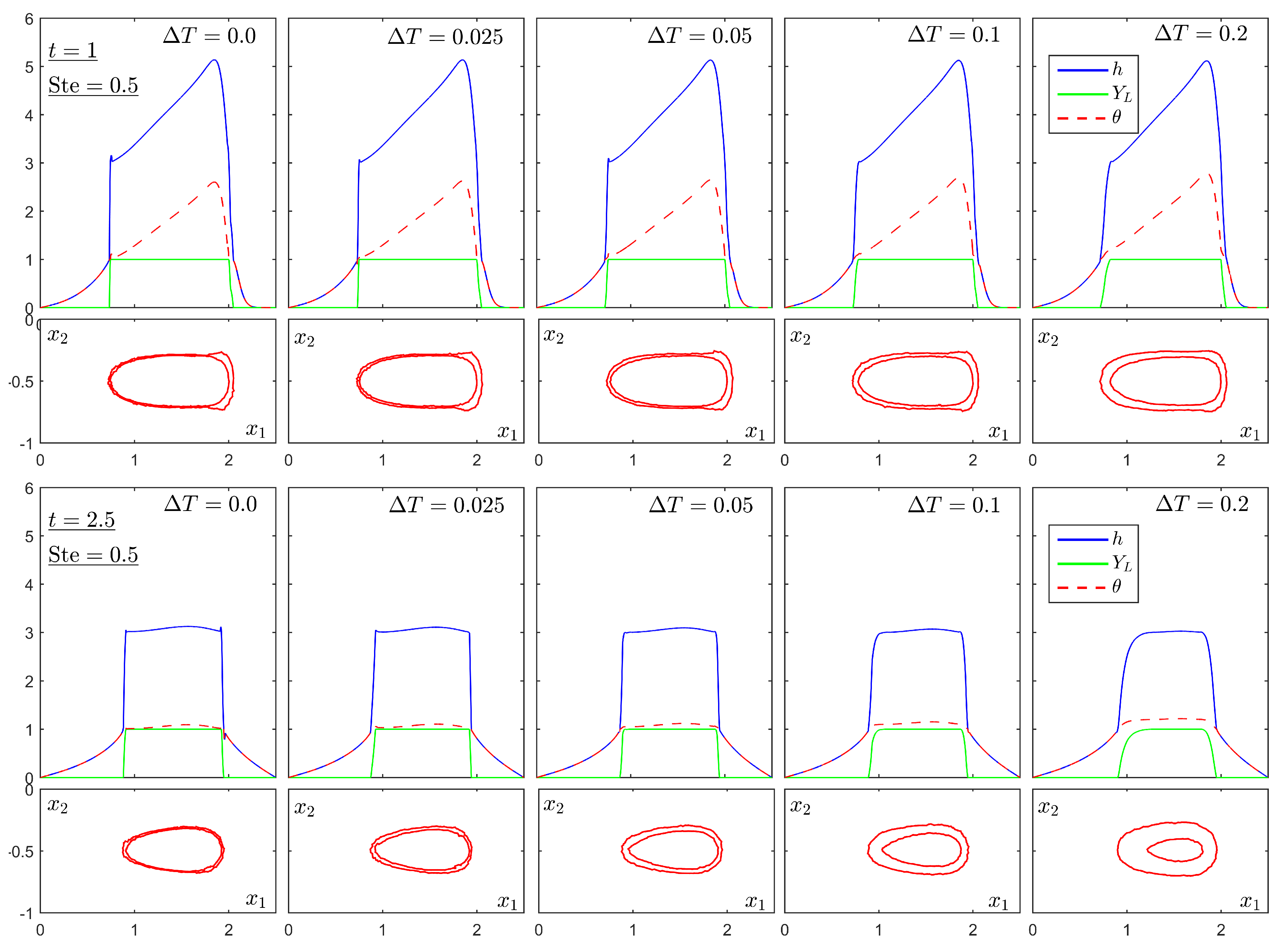Numerical Solution of Thermal Phenomena in Welding Problems
Abstract
1. Introduction
2. Governing Equations
- Constant density at the three regions, as in [13].
- The intensity of the convective currents in the liquid zone is negligible; i.e., the velocity at each material point. That is, we consider problems at low Grashof number limit , so there is no motion caused by the buoyancy forces. Otherwise, mass and momentum equations for the fluid motion would need to be considered.
- Radiation and evaporation are not considered in this study.
- The equations of elasticity—which take into account deformations and stresses in the material—and electromagnetism—which model the effect of the laser-arc heat source—are not considered in this study.
- The specific heat coefficient and the thermal conductivity depend on the state of the material but not on the temperature. Nevertheless, the present method can be easily extended to the more realistic case of temperature-dependent thermal coefficients; see Remark 3.
Non-Dimensional Formulation
3. Numerical Discretization of the Problem
3.1. The -Newton Algorithm
3.2. Mesh Refinement
4. Results
4.1. Test I: Convergence and Computational Cost Analysis
4.2. Test II: Gaussian-Type Heat Source
5. Conclusions
Author Contributions
Funding
Institutional Review Board Statement
Informed Consent Statement
Data Availability Statement
Conflicts of Interest
Appendix A. Analytical Solution of Test I
- For , all the material is solid state and the solution is given by (A4).
References
- Karkhin, V.A. Engineering Materials Thermal Processes in Welding; Springer: Berlin/Heidelberg, Germany, 2018. [Google Scholar]
- Atthey, D.R. A finite difference scheme for melting problems. IMA J. Appl. Math. Inst. Math. Its Appl. 1974, 13, 353–366. [Google Scholar] [CrossRef]
- Meirmanov, M.A. The Stefan Problem; Walter de Gruyter Expositions in Mathematics; De Gruyter: Berlin, Germany, 1992. [Google Scholar]
- Oleinik, O.A. A method of solution of the general Stefan problem. Sov. Math. Dokl. 1960, 1, 1350–1354. [Google Scholar]
- Kamenomostskaya, S.L. On the stefan problem. Mat. Sb. 1961, 53, 489–514. [Google Scholar]
- White, E.R. An enthalpy formulation of the Stefan problem. SIAM J. Numer. Anal. 1982, 19, 1129–1157. [Google Scholar] [CrossRef]
- Turichin, G.; Mukin, D.; Valdaytseva, E.; Sannikov, M. Influence of Latent Heat of Fusion on the Melt Pool Shape and Size in the Direct Laser Deposition Process. Materials 2022, 15, 8349. [Google Scholar] [CrossRef] [PubMed]
- Piekarska, W.; Kubiak, M. Three-dimensional model for numerical analysis of thermal phenomena in laser-arc hybrid welding process. Int. J. Heat Mass Transf. 2011, 54, 4966–4974. [Google Scholar] [CrossRef]
- Piekarska, W.; Kubiak, M. Modeling of thermal phenomena in single laser beam and laser-arc hybrid welding processes using projection method. Appl. Math. Model. 2013, 37, 2051–2062. [Google Scholar] [CrossRef]
- Danaila, I.; Moglan, R.; Hecht, F.; Masson, S.L. A Newton method with adaptive finite elements for solving phase-change problems with natural convection. J. Comput. Phys. 2014, 274, 826–840. [Google Scholar] [CrossRef]
- Kubiak, M.; Piekarska, W. Comprehensive model of thermal phenomena and phase transformations in laser welding process. Comput. Struct. 2016, 172, 29–39. [Google Scholar] [CrossRef]
- Wu, J.; Zhang, H.; Feng, Y.; Luo, B. 3D Multiphysical Modelling of Fluid Dynamics and Mass Transfer in Laser Welding of Dissimilar Materials. Metals 2018, 8, 443. [Google Scholar] [CrossRef]
- Rakotondrandisa, A.; Sadaka, G.; Danaila, I. A finite-element toolbox for the simulation of solid-liquid phase-change systems with natural convection. Comput. Phys. Commun. 2020, 253, 107188. [Google Scholar] [CrossRef]
- Díaz Moreno, J.M.; García Vázquez, C.; González Montesinos, M.T.; Ortegón Gallego, F.; Viglialoro, G. Industrial Steel Heat Treating: Numerical Simulation of Induction Heating and Aquaquenching Cooling with Mechanical Effects. Mathematics 2021, 9, 1203. [Google Scholar] [CrossRef]
- Atta, D. Thermal Diffusion Responses in an Infinite Medium with a Spherical Cavity using the Atangana-Baleanu Fractional Operator. J. Appl. Comput. Mech. 2022, 8, 1358–1369. [Google Scholar] [CrossRef]
- Nedjar, B. An enthalpy-based finite element method for nonlinear heat problems involving phase change. Comput. Struct. 2002, 80, 9–21. [Google Scholar] [CrossRef]
- Barral, P.; Bermúdez, A.; Muñiz, M.C.; Otero, M.V.; Quintela, P.; Salgado, P. Numerical simulation of some problems related to aluminium casting. J. Mater. Process. Technol. 2003, 142, 383–399. [Google Scholar] [CrossRef]
- Bermúdez, A.; Otero, M.V. Numerical solution of a three-dimensional solidification problem in aluminium casting. Finite Elem. Anal. Des. 2004, 40, 1885–1906. [Google Scholar] [CrossRef]
- Álvarez-Hostos, J.C.; Bencomo, A.D.; Puchi-Cabrera, E.S.; Fachinotti, V.D.; Tourn, B.; Salazar-Bove, J.C. Implementation of a standard stream-upwind stabilization scheme in the element-free Galerkin based solution of advection-dominated heat transfer problems during solidification in direct chill casting processes. Eng. Anal. Bound. Elem. 2019, 106, 170–181. [Google Scholar] [CrossRef]
- Shibahara, M.; Atluri, S.N. The meshless local Petrov-Galerkin method for the analysis of heat conduction due to a moving heat source, in welding. Int. J. Therm. Sci. 2011, 50, 984–992. [Google Scholar] [CrossRef]
- Anca, A.; Cardona, A.; Risso, J.; Fachinotti, V.D. Finite element modeling of welding processes. Appl. Math. Model. 2011, 35, 688–707. [Google Scholar] [CrossRef]
- Carpio, J.; Prieto, J.L. An anisotropic, fully adaptive algorithm for the solution of convection-dominated equations with semi-Lagrangian schemes. Comput. Methods Appl. Mech. Eng. 2014, 273, 77–99. [Google Scholar] [CrossRef]
- Özisik, M.N. Boundary Value Problems of Heat Conduction; Dover Publications Inc.: New York, NY, USA, 1989. [Google Scholar]
- McBride, B.J.; Zehe, M.J.; Gordon, S. NASA Glenn Coefficients for Calculating Thermodynamic Properties of Individual Species; Technical Report NASA/TP-2002-211556; NASA: Washington, DC, USA, 2002.
- Hecht, F. BAMG: Bidimensional Anisotropic Mesh Generator. 2006. Available online: https://www.ljll.math.upmc.fr/~hecht/ftp/bamg/bamg.pdf (accessed on 1 June 2023).










Disclaimer/Publisher’s Note: The statements, opinions and data contained in all publications are solely those of the individual author(s) and contributor(s) and not of MDPI and/or the editor(s). MDPI and/or the editor(s) disclaim responsibility for any injury to people or property resulting from any ideas, methods, instructions or products referred to in the content. |
© 2023 by the authors. Licensee MDPI, Basel, Switzerland. This article is an open access article distributed under the terms and conditions of the Creative Commons Attribution (CC BY) license (https://creativecommons.org/licenses/by/4.0/).
Share and Cite
Freire-Torres, M.; Colera, M.; Carpio, J. Numerical Solution of Thermal Phenomena in Welding Problems. Mathematics 2023, 11, 3009. https://doi.org/10.3390/math11133009
Freire-Torres M, Colera M, Carpio J. Numerical Solution of Thermal Phenomena in Welding Problems. Mathematics. 2023; 11(13):3009. https://doi.org/10.3390/math11133009
Chicago/Turabian StyleFreire-Torres, Mario, Manuel Colera, and Jaime Carpio. 2023. "Numerical Solution of Thermal Phenomena in Welding Problems" Mathematics 11, no. 13: 3009. https://doi.org/10.3390/math11133009
APA StyleFreire-Torres, M., Colera, M., & Carpio, J. (2023). Numerical Solution of Thermal Phenomena in Welding Problems. Mathematics, 11(13), 3009. https://doi.org/10.3390/math11133009





